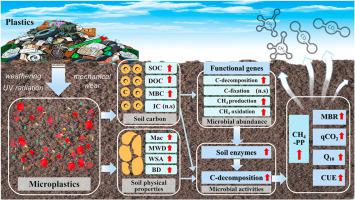当前位置:
X-MOL 学术
›
Soil Biol. Biochem.
›
论文详情
Our official English website, www.x-mol.net, welcomes your feedback! (Note: you will need to create a separate account there.)
Stimulated soil CO2 and CH4 emissions by microplastics: A hierarchical perspective
Soil Biology and Biochemistry ( IF 9.7 ) Pub Date : 2024-04-08 , DOI: 10.1016/j.soilbio.2024.109425 Pinjie Su , Naishun Bu , Xingyu Liu , Qiqi Sun , Jiale Wang , Xiaojing Zhang , Tingting Xiang , Kuo Chu , Zhaoxing Zhang , Xiaoxu Cao , Zhaolei Li
Soil Biology and Biochemistry ( IF 9.7 ) Pub Date : 2024-04-08 , DOI: 10.1016/j.soilbio.2024.109425 Pinjie Su , Naishun Bu , Xingyu Liu , Qiqi Sun , Jiale Wang , Xiaojing Zhang , Tingting Xiang , Kuo Chu , Zhaoxing Zhang , Xiaoxu Cao , Zhaolei Li

|
Microplastics have become ubiquitous in soils on a global scale, which may elicit profound deleterious impacts on soil health. However, contradictory case studies have prevented a clear understanding of how microplastics hierarchically impact soil carbon cycling. A meta-analysis was performed to systematically elucidate the effects of microplastics on carbon cycling, particularly in terms of CO and CH emissions. Upon exposure to microplastics, the overall soil CO emissions increased by 54.3%, as were the soil organic carbon (22.6%), dissolved organic carbon (13.3%), and microbial biomass carbon (5.5%). Sufficient carbon substrates supported the replication of functional genes that governed the decomposition of carbon (4.0%; e.g., , , and , etc.), whereas the gene copies for carbon fixation ( and ) were negligibly affected. Moreover, soil enzymatic (e.g., dehydrogenase, fluorescein diacetate hydrolase, and chitinase) activities were also enhanced. Meanwhile, the CO emissions were positively correlated with the gene copy numbers of carbon-decomposing microorganisms. Similarly, the soil CH emissions increased by 9.7%, where the increment of methanogen (41.1%; ) was slightly higher than that of methanotrophs (37.9%; , and ). Moreover, CH emissions were positively correlated with methanogen gene copies, and the increment of CH emissions was more pronounced in paddy soil (11.3%) than in upland soil. Microplastics with smaller dimensions, round shapes, higher concentrations, and biodegradability leaded to higher soil CO and CH emissions. Meanwhile, the effect sizes of CO and CH emissions decreased over time. These findings revealed that soil carbon cycling was expedited following microplastics exposure, which should be factored into future environmental risk assessments.
中文翻译:

微塑料刺激土壤二氧化碳和甲烷排放:分层视角
微塑料在全球范围内的土壤中无处不在,这可能对土壤健康造成深远的有害影响。然而,相互矛盾的案例研究阻碍了人们对微塑料如何分层影响土壤碳循环的清晰理解。进行了一项荟萃分析,系统地阐明了微塑料对碳循环的影响,特别是在二氧化碳和甲烷排放方面。接触微塑料后,土壤二氧化碳排放总量增加了54.3%,土壤有机碳(22.6%)、溶解有机碳(13.3%)和微生物生物量碳(5.5%)也增加了。足够的碳底物支持控制碳分解的功能基因的复制(4.0%;例如, 、 和 等),而碳固定的基因拷贝( 和 )受到的影响可以忽略不计。此外,土壤酶(例如脱氢酶、荧光素二乙酸水解酶和几丁质酶)活性也得到增强。同时,CO排放量与碳分解微生物的基因拷贝数呈正相关。同样,土壤CH排放量增加了9.7%,其中产甲烷菌的增量(41.1%; )略高于甲烷氧化菌的增量(37.9%; 和 )。此外,CH排放量与产甲烷菌基因拷贝数呈正相关,且水稻土CH排放量的增量(11.3%)比旱地土壤更显着。尺寸更小、形状更圆、浓度更高且可生物降解的微塑料导致土壤二氧化碳和甲烷排放量更高。与此同时,二氧化碳和甲烷排放的影响大小随着时间的推移而减小。这些发现表明,微塑料暴露后土壤碳循环加速,这应纳入未来的环境风险评估。
更新日期:2024-04-08
中文翻译:

微塑料刺激土壤二氧化碳和甲烷排放:分层视角
微塑料在全球范围内的土壤中无处不在,这可能对土壤健康造成深远的有害影响。然而,相互矛盾的案例研究阻碍了人们对微塑料如何分层影响土壤碳循环的清晰理解。进行了一项荟萃分析,系统地阐明了微塑料对碳循环的影响,特别是在二氧化碳和甲烷排放方面。接触微塑料后,土壤二氧化碳排放总量增加了54.3%,土壤有机碳(22.6%)、溶解有机碳(13.3%)和微生物生物量碳(5.5%)也增加了。足够的碳底物支持控制碳分解的功能基因的复制(4.0%;例如, 、 和 等),而碳固定的基因拷贝( 和 )受到的影响可以忽略不计。此外,土壤酶(例如脱氢酶、荧光素二乙酸水解酶和几丁质酶)活性也得到增强。同时,CO排放量与碳分解微生物的基因拷贝数呈正相关。同样,土壤CH排放量增加了9.7%,其中产甲烷菌的增量(41.1%; )略高于甲烷氧化菌的增量(37.9%; 和 )。此外,CH排放量与产甲烷菌基因拷贝数呈正相关,且水稻土CH排放量的增量(11.3%)比旱地土壤更显着。尺寸更小、形状更圆、浓度更高且可生物降解的微塑料导致土壤二氧化碳和甲烷排放量更高。与此同时,二氧化碳和甲烷排放的影响大小随着时间的推移而减小。这些发现表明,微塑料暴露后土壤碳循环加速,这应纳入未来的环境风险评估。



























 京公网安备 11010802027423号
京公网安备 11010802027423号